Alaska Railroad embarks on a remarkable journey through the heart of Alaska, weaving a tapestry of history, breathtaking scenery, and economic vitality. From its inception to its enduring legacy, the railroad has played a pivotal role in shaping the region’s identity and connecting communities.
Spanning over 470 miles of rugged terrain, the Alaska Railroad offers a unique perspective on the untamed beauty of the Last Frontier. Passengers can marvel at the towering peaks of Denali National Park, traverse the Chugach Mountains, and witness wildlife in their natural habitat.
Historical Background
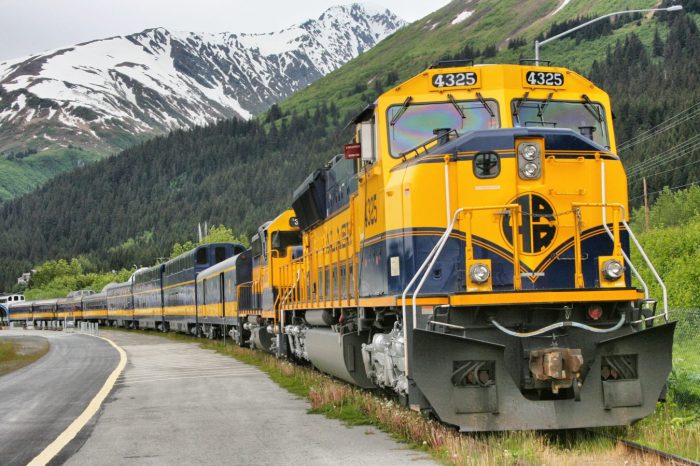
The Alaska Railroad, a vital transportation artery in the vast wilderness of Alaska, has a rich history deeply intertwined with the economic and social development of the state. Its origins trace back to the late 19th century, during the height of the gold rush era.
In 1898, the discovery of gold in the Klondike region of Canada sparked a massive influx of prospectors into Alaska. However, the rugged terrain and lack of infrastructure made transportation extremely challenging. Recognizing the need for a reliable means of moving people and goods, the United States Congress authorized the construction of a railroad in 1903.
Construction and Early Years
The construction of the Alaska Railroad was a monumental undertaking that faced numerous challenges. The route traversed treacherous mountains, frozen rivers, and dense forests, requiring the use of innovative engineering techniques. Despite the hardships, the railroad was completed in 1914, stretching over 470 miles from Seward on the southern coast to Fairbanks in the interior.
The railroad played a crucial role in the early development of Alaska. It provided a lifeline for miners, settlers, and businesses, enabling the transportation of supplies, equipment, and people to remote areas. It also spurred the growth of towns and industries along its route.
Expansion and Modernization
In the decades that followed, the Alaska Railroad underwent several expansions and upgrades. In 1923, the line was extended to Anchorage, the state’s largest city. Later, during World War II, the railroad played a significant role in the defense of Alaska and the Aleutian Islands.
In the post-war era, the railroad continued to modernize, adopting diesel locomotives and implementing new technologies to improve efficiency and safety. Today, the Alaska Railroad remains a vital transportation system, carrying both passengers and freight, and serving as a key economic driver for the state.
Route and Operations
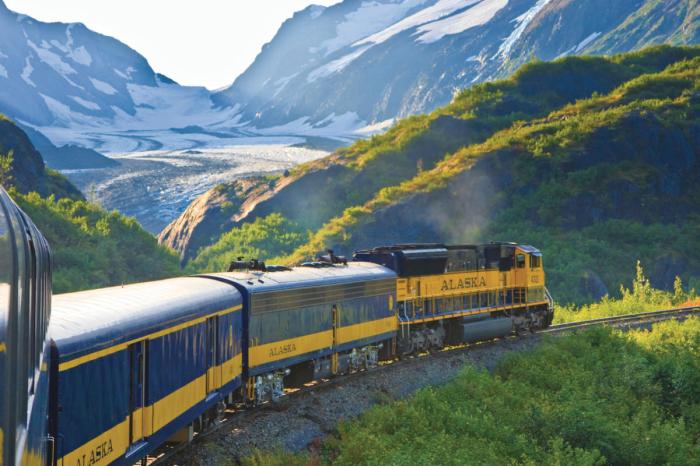
The Alaska Railroad spans 470 miles (756 kilometers) from Seward on the southern coast to Fairbanks in the interior. Along its route, the railroad serves several major stations and stops, including:
- Seward: The southern terminus of the railroad, located on Resurrection Bay.
- Anchorage: The largest city in Alaska and a major stop on the railroad.
- Denali National Park and Preserve: A popular tourist destination home to Mount Denali, the highest peak in North America.
- Fairbanks: The northern terminus of the railroad and the second-largest city in Alaska.
The Alaska Railroad operates a variety of trains, including passenger trains, freight trains, and excursion trains. Passenger trains offer scenic views of Alaska’s wilderness and wildlife, while freight trains transport goods and materials throughout the state. Excursion trains provide special experiences, such as the Denali Star train, which offers a day trip to Denali National Park.
Train Schedules and Fares
The Alaska Railroad’s train schedules and fares vary depending on the type of train and the time of year. Passenger trains typically operate daily during the summer months, with reduced service during the winter. Freight trains operate year-round, while excursion trains have limited seasonal schedules.
Fares for passenger trains vary based on the distance traveled and the class of service. Economy class tickets are the most affordable, while first-class tickets offer more amenities and comfort. Freight train fares are determined by the weight and type of goods being transported.
Scenic Attractions
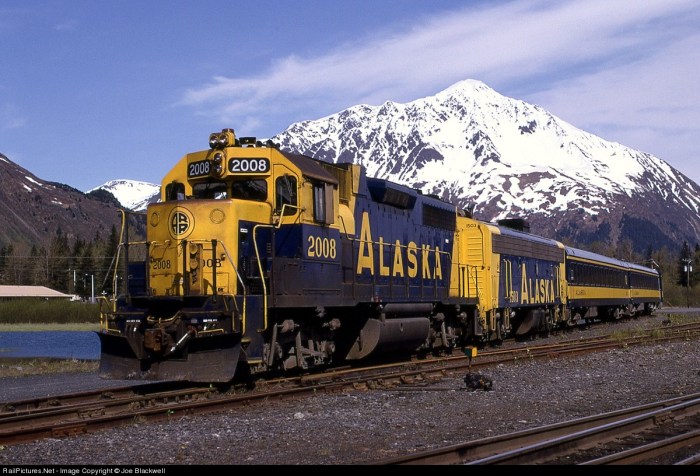
The Alaska Railroad winds through some of the most breathtaking scenery in the world, offering passengers unparalleled views of Alaska’s natural beauty. From the towering peaks of Denali to the pristine waters of Turnagain Arm, the route is a feast for the eyes.
Wildlife Viewing, Alaska railroad
The Alaska Railroad is a great way to see Alaska’s wildlife. Passengers can often spot moose, caribou, bears, and eagles from the train windows. The train also makes several stops in areas known for wildlife viewing, such as Denali National Park and Portage Glacier.
Outdoor Activities
In addition to wildlife viewing, the Alaska Railroad offers passengers a variety of outdoor activities. Passengers can hike, bike, fish, and kayak in the many parks and recreation areas along the route. The train also makes stops at several trailheads and boat launches, making it easy for passengers to explore the Alaskan wilderness.
If you’re planning a trip on the Alaska Railroad, be sure to pack for the elements. While the scenery is beautiful, the weather can be unpredictable. However, if you’re planning a beach holiday, you can refer to this beach holiday packing list to make sure you have everything you need to enjoy your trip.
Don’t forget to pack your swimsuit, sunscreen, and sunglasses for those sunny days on the Alaska Railroad.
Tourism and Economic Impact

The Alaska Railroad plays a crucial role in promoting tourism and economic development in the region. The railroad offers scenic train journeys that provide tourists with access to breathtaking landscapes, wildlife viewing opportunities, and historical sites. The train’s routes connect major cities and towns, making it a convenient and immersive way to explore Alaska.
Partnerships and Collaborations
The Alaska Railroad has established partnerships and collaborations with other tourism businesses to enhance the visitor experience. These partnerships include joint marketing campaigns, package deals, and collaborations with tour operators. By working together, these businesses create a comprehensive and interconnected tourism ecosystem that benefits both visitors and the local economy.
Engineering and Infrastructure
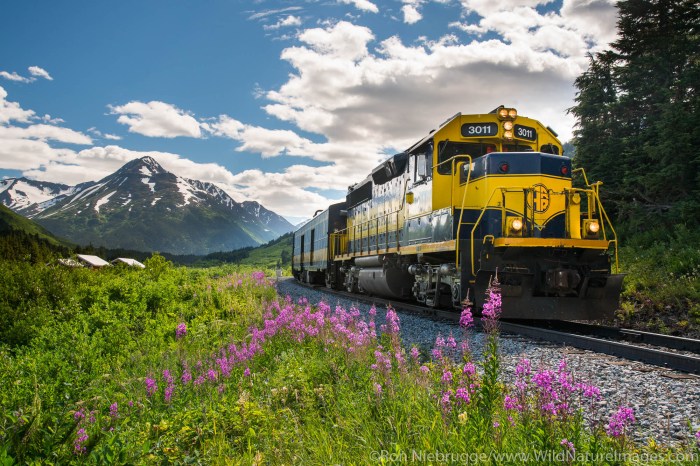
The construction and maintenance of the Alaska Railroad presented significant engineering challenges due to the harsh and remote environment it traverses. The terrain is characterized by rugged mountains, vast wilderness, and extreme weather conditions.
Innovative engineering solutions were employed to overcome these obstacles. The railroad’s route was carefully planned to minimize grades and curves, and specialized equipment was developed to handle the steep terrain and permafrost conditions.
Specialized Equipment
The Alaska Railroad utilized specialized equipment, such as rotary snowplows and ballast regulators, to ensure safe and efficient operations in the challenging Alaskan environment.
The Alaska Railroad, with its scenic routes and historic charm, offers an unforgettable journey through the breathtaking Alaskan wilderness. But if you’re yearning for a tropical escape, why not consider exploring the best beaches in the Caribbean ? With crystal-clear waters, pristine sands, and vibrant coral reefs, the Caribbean offers a slice of paradise that’s sure to revitalize and inspire.
While the Alaska Railroad whisks you through pristine landscapes, the Caribbean beckons you to embrace the allure of sun-drenched shores.
- Rotary Snowplows: These powerful machines were designed to clear heavy snowdrifts that accumulate during the long winter months.
- Ballast Regulators: These machines were used to maintain the railroad’s track by distributing and leveling ballast, which provides stability and drainage.
Environmental Sustainability

The Alaska Railroad is dedicated to environmental sustainability, recognizing the importance of preserving the pristine wilderness through which it operates.
To reduce its carbon footprint, the railroad has implemented various initiatives, including the use of Tier 4 locomotives that meet strict emission standards. These locomotives are designed to reduce particulate matter and nitrogen oxide emissions significantly.
Renewable Energy Sources
The railroad is exploring renewable energy sources to power its operations. It has partnered with local utilities to purchase renewable energy credits and is investigating the potential of solar and wind energy.
The Alaska Railroad is an iconic train journey that offers a unique way to experience the breathtaking scenery of Alaska. Its commitment to sustainability makes it a great choice for travelers seeking sustainable travel destinations. The railroad uses renewable energy sources, conserves water, and supports local communities.
By choosing the Alaska Railroad, travelers can enjoy an unforgettable journey while minimizing their environmental impact.
Wildlife Protection
The Alaska Railroad recognizes the importance of protecting the diverse wildlife along its routes. It has implemented measures to minimize the impact on wildlife, including wildlife crossings, fencing, and educational programs for employees and passengers.
The railroad also collaborates with wildlife organizations to monitor and protect endangered species, such as the bald eagle and the Dall sheep.
Other Eco-Friendly Practices
- Waste reduction and recycling programs
- Water conservation measures
- Sustainable procurement practices
- Employee education and awareness campaigns
Cultural and Historical Significance
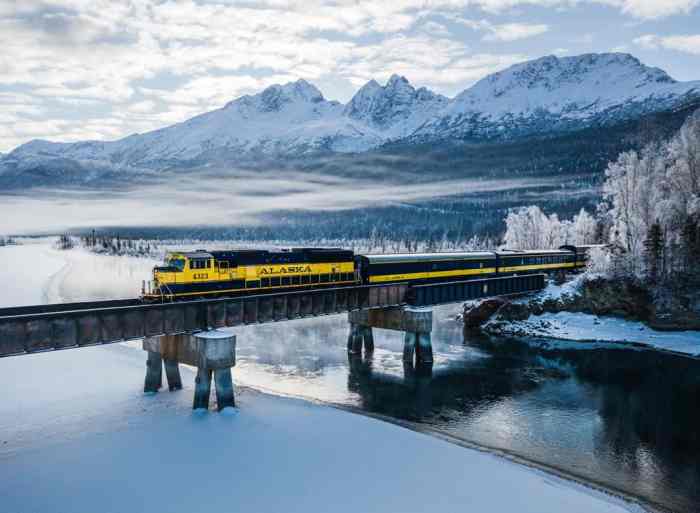
The Alaska Railroad holds immense cultural and historical significance, shaping the region’s identity and heritage. Its construction in the early 20th century played a pivotal role in connecting remote communities and fostering economic growth.
Indigenous Connections
The railroad established vital links between indigenous communities, facilitating access to healthcare, education, and employment opportunities. It also provided a means for cultural exchange and the preservation of traditional practices.
Preserving Cultural Traditions
The railroad has actively supported the preservation of indigenous cultures through partnerships with local organizations. These efforts include funding for cultural programs, supporting traditional language revitalization, and promoting indigenous art and crafts.
Future Plans and Developments

The Alaska Railroad has ambitious plans for the future, aiming to expand its reach, enhance its operations, and embrace technological advancements. These initiatives are driven by the railroad’s commitment to providing reliable, efficient, and sustainable transportation services while contributing to the economic growth and development of Alaska.
The railroad is exploring potential new routes to connect remote communities and increase access to transportation options. These routes could provide vital links to resources, markets, and tourism destinations, fostering economic development and improving the quality of life for residents. Additionally, the railroad is seeking partnerships with other transportation providers, such as airlines and trucking companies, to offer seamless intermodal transportation solutions.
Embracing technological advancements is another key aspect of the Alaska Railroad’s future plans. The railroad is investigating the use of autonomous trains, which have the potential to improve safety, efficiency, and cost-effectiveness. Additionally, the railroad is exploring the implementation of advanced data analytics and predictive maintenance technologies to optimize operations and reduce downtime.
Ending Remarks

As the Alaska Railroad continues to evolve, it remains a testament to the ingenuity and perseverance of those who built it. Its commitment to environmental sustainability, cultural preservation, and economic development ensures that its legacy will endure for generations to come.
General Inquiries: Alaska Railroad
What is the Alaska Railroad?
The Alaska Railroad is a historic and scenic railroad that runs through the heart of Alaska, connecting Seward to Fairbanks.
What are the highlights of the Alaska Railroad route?
The Alaska Railroad route offers stunning views of Denali National Park, the Chugach Mountains, and abundant wildlife.
What types of trains operate on the Alaska Railroad?
The Alaska Railroad operates a variety of trains, including passenger trains, freight trains, and special excursion trains.
What is the significance of the Alaska Railroad?
The Alaska Railroad played a crucial role in the economic and social development of Alaska, connecting communities and transporting goods and resources.